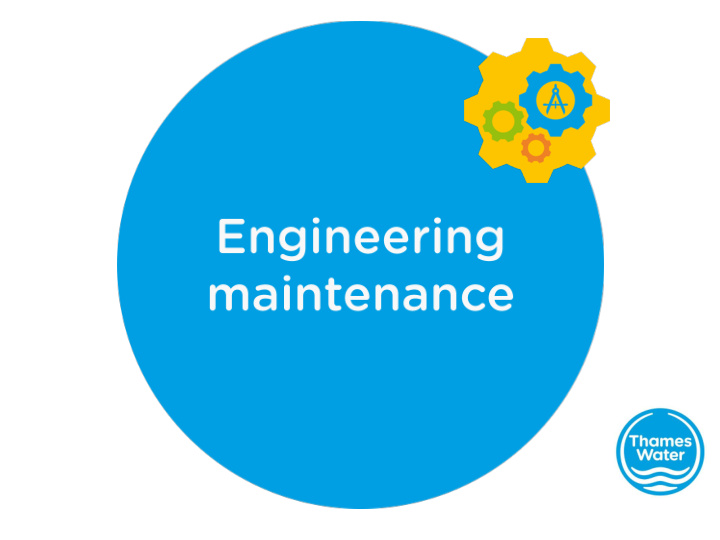



Question Question: What is maintenance? 2
Answer The work of keeping something in proper condition, care or upkeep including: taking steps to avoid something breaking down and bringing something back to working order. 3
Question Question: What do you think is meant by each of the following types of planned maintenance? 4
Types of planned maintenance Routine maintenance Preventative maintenance Predictive maintenance 5
Types of planned maintenance Routine maintenance: Routine maintenance is the upkeep practices that an organisation performs on a regular basis in order to prevent harm to workers and large-scale, expensive repairs to equipment. Preventative maintenance: Preventative maintenance is maintenance that is regularly performed on a piece of equipment to lessen the likelihood of it failing. Preventative maintenance is performed while the equipment is still working, so that it does not break down unexpectedly. Predictive maintenance: Predictive maintenance is designed to help determine the condition of equipment in order to predict when maintenance should be performed. This approach promises cost savings over routine or time-based preventive maintenance, because tasks are performed only when warranted. 6
Operation of 102 water treatment works, 26 raw water reservoirs, 288 pumping stations and 235 clean water service reservoirs UK’s largest water 4,700 employees and wastewater and 15 million provider customers 67,000 miles of An average of sewer, 2,530 pumping stations, 2,600m litres of drinking water 350 sewage works and 1.2 supplied per day million manholes 7
Question Question: Why do you think maintenance procedures are important to Thames Water’s business? 8
What is a sludge pump? A sludge pump is a pump used to push sludge into a Thermal Hydrolysis Plant (THP) where it is blasted with steam to break down the cells of the waste material (sludge) so that it produces biogas more efficiently when it is put into the digesters. Biogas is produced through the breakdown of organic matter in the absence of oxygen which is fed into a digester, heated and stirred - slowly producing a combination of methane, carbon dioxide and other gases known as biogas. Biogas can then be used for power generation. See the flow diagram on the following slide which demonstrates the production of biogas from sludge. 9
What is a sludge pump? 11
Question Question: What types of failure might you expect to see on a sludge pump? 12
Answers The pump may ‘trip out’ (blow the fuse) due to it being overloaded - drawing too much electrical current. This is usually caused by a blockage with rags/wet wipes/sanitary towels/cotton wool/blue paper towels etc. Flow sensors monitor the output of the pump and if the flow sensor detects too little flow it activates a micro sensor that turns off the pump. This could be due to a blockage or can be caused by stator wear due to abrasion from grit or other substances in the sludge. The rotor and stator have fine tolerances and if the rubber stator is damaged by abrasion the pump may fail. Excessive vibration/noise. 13
Components within a sludge pump What is a rotor and stator? A rotor is a rotating part of a motor or an AC machine, it is used to transmit the motor forces to the output shaft (in this instance the sludge pump). The stator is the static or stationary part. When the rotor rotates in the stator, cavities are formed and progressed (moved along) during the rotation. Due to the construction, the sludge within the stator is pushed along to the outlet. 14
Components within a sludge pump Rotor Stator 15
Components within a sludge pump Rotor Stator 16
Question Question: What types of fault might you expect to see on a rotor and stator? 17
Typical faults within the rotor and stator Typical motor abrasive wear pattern – as seen in the ridges 18
Typical faults within the rotor and stator Abrasive wear on a rotor. Note the ‘grooves’ or ridges. 19
Typical faults within the rotor and stator Chemical attack undermining the carbon steel base metal through the chrome plating. 20
Typical faults within the rotor and stator The inner surface of a run dry stator is hard and has a very rough texture. The pump dry running can cause the stator to burn creating a loss in performance. 21
Question Question: What do you think are the knock-on effects / implications of these failures? 22
Answers If the pump fails then sludge is unable to be pumped into the THP (Thermal Hydrolysis Plant), this would have the effect of reducing or stopping the production of biogas and therefore the Sewage Treatment Works would need to rely on the National Grid for its power requirement. The digesters, (which contain bacteria that digests the sludge and produces approximately 65% methane, carbon dioxide and other gases), would no longer receive sludge and therefore the digester would eventually stop producing biogas. The bacteria that digest the sludge may die and a new ‘feedstock’ may need to be introduced – this can cause delays in the production of the biogas and the efficiency of the plant and have a significant financial cost. 23
Maintenance Typical maintenance to the pump would generally be reactive due to the nature of the failures it experiences. Maintenance of wearing components – rotor and stator The wear rate on these components is dependent on many factors, such as product abrasivity, speed, pressure etc. When pump performance has reduced to an unacceptable level one or possibly both items are replaced. The parts most commonly changed under routine maintenance would usually be the rubber stator, metal rotor and bearings. 24
Maintenance Recommended maintenance intervals for the sludge pump (see last column) 25
Recommend
More recommend